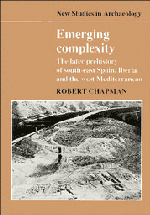Book contents
- Frontmatter
- Contents
- List of figures
- List of tables
- Preface
- 1 Two tribes: questions of theory, scale and explanation
- 2 Hello, goodbye: Iberian prehistory and traditional archaeology
- 3 Another one bites the dust: the implications of the absolute chronology
- 4 Getting better: south-east Spain, the cultural framework 5000–500 bc
- 5 Dancin' in the dark? Adaptation and intensification in south–east Spain
- 6 Centrefield: recent models of intensification and cultural change in south-east Spain
- 7 Into the groove: system scale and technological innovation in south-east Spain
- 8 Out of reach? Complexity, interaction and integration in south-east Spain
- 9 Eliminator: models and the archaeological record in south-east Spain
- 10 Strong persuader: intensification and interaction in Iberia and the west Mediterranean
- 11 With or without you: variability, evaluation and complexity
- Bibliography
- Index
3 - Another one bites the dust: the implications of the absolute chronology
Published online by Cambridge University Press: 05 March 2012
- Frontmatter
- Contents
- List of figures
- List of tables
- Preface
- 1 Two tribes: questions of theory, scale and explanation
- 2 Hello, goodbye: Iberian prehistory and traditional archaeology
- 3 Another one bites the dust: the implications of the absolute chronology
- 4 Getting better: south-east Spain, the cultural framework 5000–500 bc
- 5 Dancin' in the dark? Adaptation and intensification in south–east Spain
- 6 Centrefield: recent models of intensification and cultural change in south-east Spain
- 7 Into the groove: system scale and technological innovation in south-east Spain
- 8 Out of reach? Complexity, interaction and integration in south-east Spain
- 9 Eliminator: models and the archaeological record in south-east Spain
- 10 Strong persuader: intensification and interaction in Iberia and the west Mediterranean
- 11 With or without you: variability, evaluation and complexity
- Bibliography
- Index
Summary
The use of absolute dating methods has taken longer to develop in Iberia than in many other parts of western Europe. When I submitted my doctoral dissertation in 1975, there were four times the number of published radiocarbon dates from France as from Iberia, while Italy (which is half the size of Iberia) possessed twice the number of dates. While there has been a notable number of dates published since 1975 (e.g. Almagro Gorbea and Fernández-Miranda 1978), there remain particular problems with their interpretation. Many sites are ‘dated’ by single determinations. Few, if any, areas can be claimed to have detailed absolute chronologies, although some finer subdivisions have become possible. For north-east Spain the details of a fifth- and fourth-millennium Neolithic sequence are becoming visible (e.g. Guilaine et al. 1982), as is also the case in Andalucía (e.g. Pellicer and Acosta 1982). Although Neolithic material outside of megalithic tombs is known from southern Portugal (e.g. Spindler 1981), there is no stratigraphic or absolute dating evidence for the development of Neolithic cultures in this area. For south-east Spain a series of Bronze Age dates are published for the Argaric culture, as we shall see below.
Caveats such as these are important if absolute dates are to be used to test some of the arguments of the traditional framework outlined in chapter 2.
- Type
- Chapter
- Information
- Emerging ComplexityThe Later Prehistory of South-East Spain, Iberia and the West Mediterranean, pp. 35 - 53Publisher: Cambridge University PressPrint publication year: 1990



